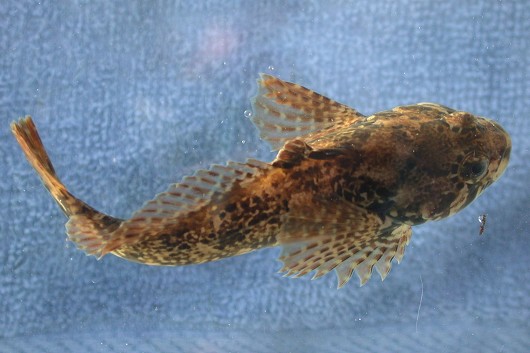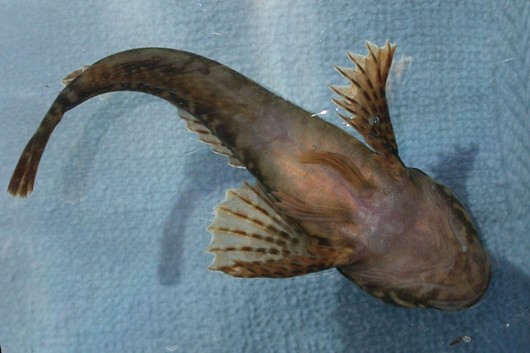Marbled Sculpin
-
Scientific NameCottus klamathensis
-
NativeNative Species
-
Identification
 Marbled sculpin, approximately 7.5 cm (3”) long, taken by Lisa Thompson and Daniel J. Drake (dorsal view). Location: Shasta River, California. Date: 12/16/2003.
Marbled sculpin, approximately 7.5 cm (3”) long, taken by Lisa Thompson and Daniel J. Drake (dorsal view). Location: Shasta River, California. Date: 12/16/2003. Marbled sculpin, approximately 7.5 cm (3”) long, taken by Lisa Thompson and Daniel J. Drake (ventral view). Location: Shasta River, California. Date: 12/16/2003
Marbled sculpin, approximately 7.5 cm (3”) long, taken by Lisa Thompson and Daniel J. Drake (ventral view). Location: Shasta River, California. Date: 12/16/2003- Small fish, over 80 mm SL unusual, 111 mm SL max
- Large wide head, widely separated eyes, flattened snout, maxillary bone doesn’t extend past rear of eye
- Smooth skin, 1 pre-opercular spine: may have 1-2 nodes below spine, 2 chin pores
- Prickling may be well developed in young, absent or limited to behind pectoral fins in adult
- Pectoral fins often checkered, body may appear “marbled”
- Dorsal fins (2) broadly joined, lack dark patch on first dorsal
- Fin rays/spines: 1st dorsal 7-8 spines, 2nd dorsal 18-22 rays, anal 13-15 rays, pectoral 14-16 rays, caudal 11-12
- Lateral line incomplete: 15-28 pores
-
Life History
Marbled sculpin are usually found in cold (<20°C) spring-fed streams that have a low gradient and adequate aquatic vegetation. They tend to occupy pools or runs with cover, where optimal temperatures might be 11-15°C. Temperatures above 15°C are considered stressful, while sustained temperatures at 25-27°C are considered lethal. In some isolated streams marbled sculpin are found to have greater temperature tolerances and may be found inhabiting riffles or shallow water. Marbled sculpin develop primarily from spring through fall each year with the largest annual growth occurring in the first year of life. After 2 years the sculpin are able to reproduce and spawning occurs from late February through March. Each female only produces 139-650 large eggs which are placed in nests under the protection of rocks. The males guard the nests which may contain eggs from multiple females. When the larvae hatch they are 6-8 mm long and fully capable of swimming. However, young sculpin tend to minimize vulnerability by staying close to the nest site. Marbled sculpin typically live up to 5 years.
-
Links to Other ResearchN / A
-
Watershed
-
Butte Watershed
-
Lost Watershed
-
Lower Klamath Watershed
-
Lower Pit Watershed
-
Salmon Watershed
-
Scott Watershed
-
Shasta Watershed
-
South Fork Trinity Watershed
-
Trinity Watershed
-
Upper Klamath Watershed
-
Please note, watersheds are at the USGS 8-digit Hydrologic Unit Code (HUC) scale, so they often include a lot of sub-watersheds. If a species occurs in any sub-watershed within the HUC, the species appears within the HUC. Link to an EPA page that shows HUCs.

